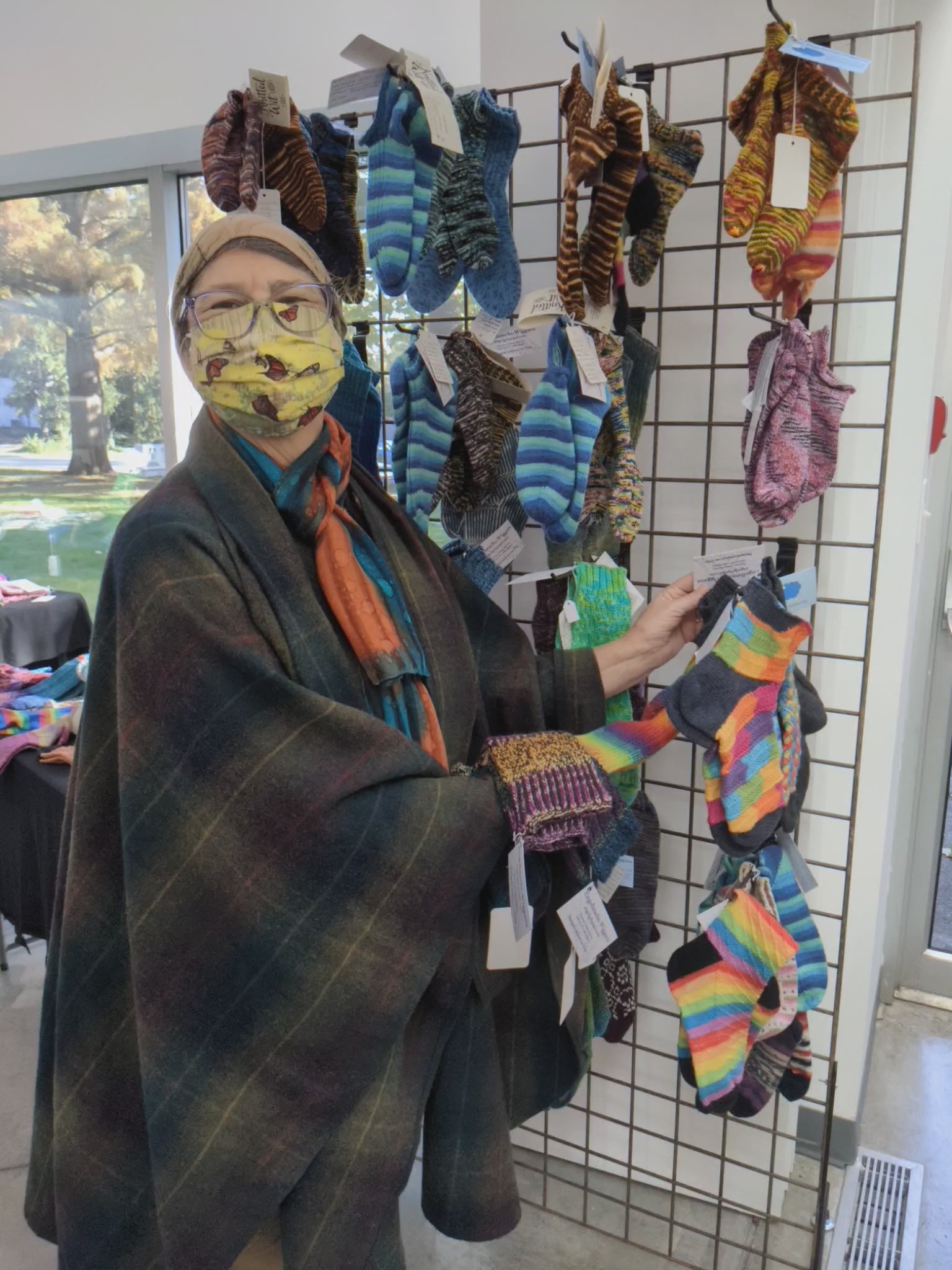
And here is the elusive @jackieLbrewer in her natural environment, with the handknit socks at the Spinners and Weavers Guild annual show and sale.


And here is the elusive @jackieLbrewer in her natural environment, with the handknit socks at the Spinners and Weavers Guild annual show and sale.
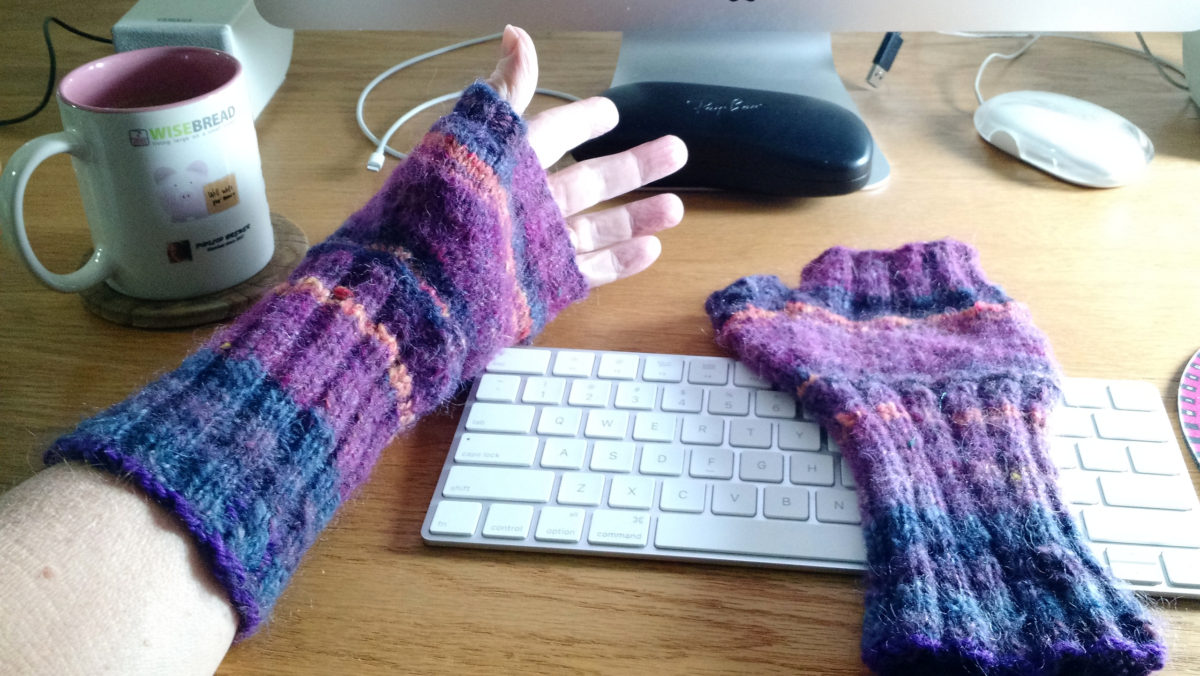
For days when it’s chilly, and yet I want to wear short sleeves, I have purple, blue and orange fingerless gauntlets.
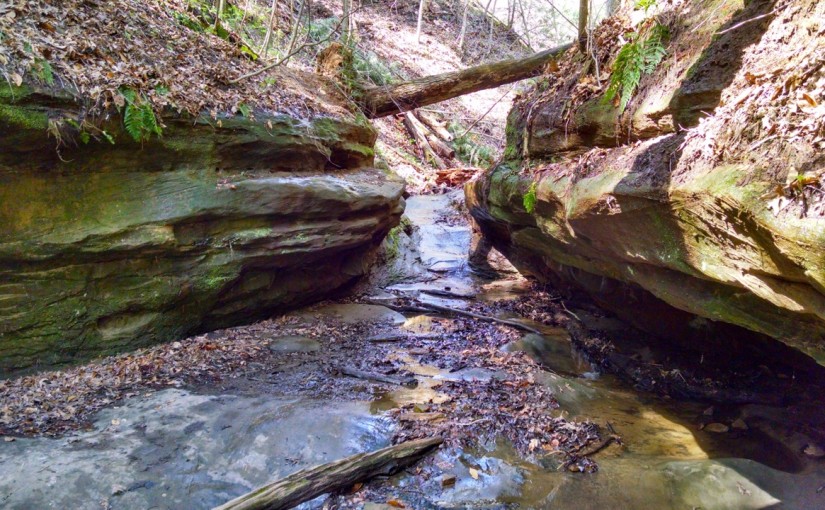
Jackie used to go to Greencastle, Indiana for the Fiber Event every year. (I think it was under different management back in those days; they called it a fleece fair.) We hadn’t gone the past couple of years, but Jackie wanted to go again this year, so we went.
Although a lot of what Jackie would buy there would sit in her stash for years, it was also a place for great finds—one year I spotted some roving made from a baby camel/merino blend that was on sale cheap because (so the vendor said) it had short fibers that made it hard to spin. But knowing that Jackie has no trouble spinning short fibers, and seeing that it was a beautiful camel-colored roving, I pointed it out and Jackie bought a bunch of it.
This year, Jackie got some yak/merino, and the vendor insisted on giving her a sample of some yak/silk blend as well.
Before coming home, having made it to that part of Indiana, Jackie and I visited Turkey Run State Park.
This time of year is a great time to visit. For one thing, there are wildflowers:
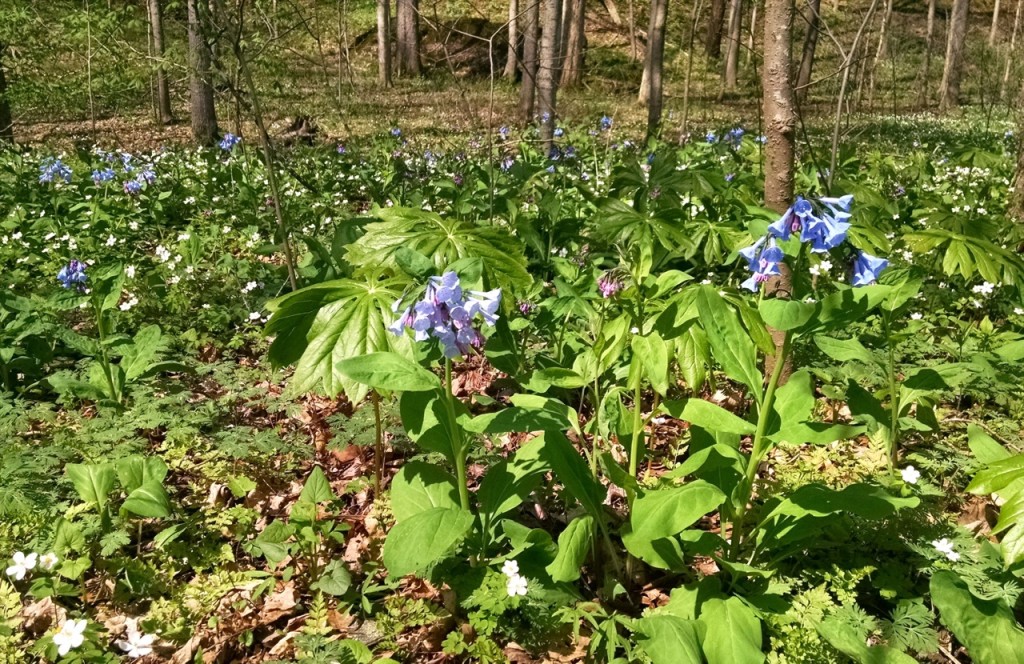
It’s a great place. My family has a long history with it—the first visit I remember was when I probably only 7 or 8 years old, and I’ve been back many times. I’ve stayed in the lodge, stayed in the cabins, and camped in the campground. And always, I’ve hiked the trails.
So, here’s a picture of me on one of the trails:
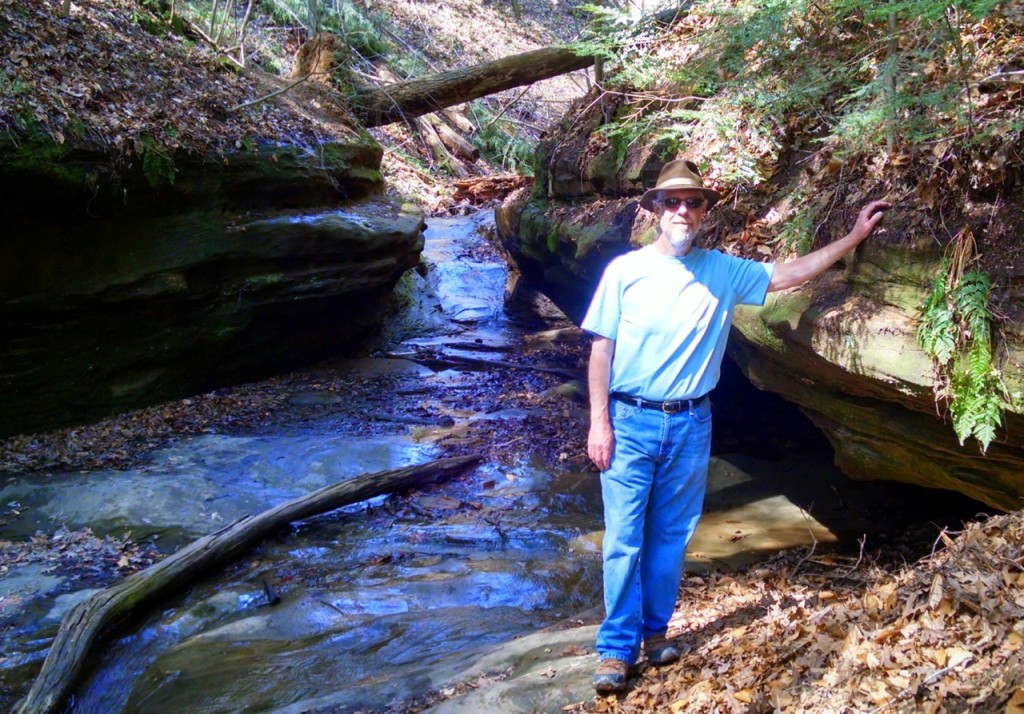
Here’s a picture of Jackie, taken not too far from there:
What a wonderful party! (“I’m making a note here: Huge success. It’s hard to overstate my satisfaction.”)
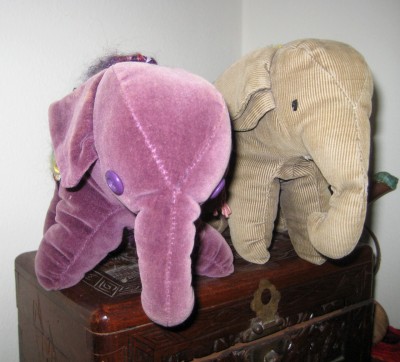
Thanks to all the folks who braved the elephants to attend! (Here’s a picture of a couple of the elephants that people had to brave.)
Jackie and I had never thrown a party together (if you don’t count our wedding reception, which was really thrown by Jackie’s mom on our behalf). Our apartment at Country Fair was too small and too cluttered for us to want to show it off. I did have a similar sort of open house party at my house in Philo when I bought it, before I met Jackie, and it was a pretty good party, but not as good as this one (because I didn’t really know anyone to invite except coworkers).
We had a great turn out. There were a bunch of taiji folks, both from the class that I attend and the class I teach, and there were a bunch of former coworkers, and a bunch of Jackie’s spinning and weaving guild members, as well representatives of the local speculative fiction writing and Esperantist communities. We had a lot of spouses and kids as well, so it was a very interesting group.
Everybody commented on how open and light our new place is, and how well it suits us. (It seems that anybody who’s lived in Champaign-Urbana for more than a few years knows somebody who lived in Winfield Village. I was initially surprised by this, but it’s so universally true, I’ve almost come to expect it.)
There was a great deal of interest in Jackie’s loom (something that you don’t see in just every house) and her spinning wheel and the yarn and woven items displayed all over the house. We don’t have much of our art hung yet, but the few pieces we have up all drew favorable comments.
I didn’t get to talk to anybody as much as I’d have liked, and barely managed to talk at all with a few people. I think future parties will be a bit smaller, so there’s more time to spend with each guest. (Sorry if I neglected you! Send me some email! Let’s do lunch!)
Pre-party preparations were a big deal of course, involving as they did unpacking all our worldly possessions and finding places for everything. Happily, post-party cleanup was almost trivial. (Because we just served snacks and deserts and not a real meal, and because we didn’t invite any undergrads.) We were mostly done cleaning up before the first Superbowl ad.
Now we have way too many deserts left over. Too much wine as well, but the wine will keep until we’re ready.
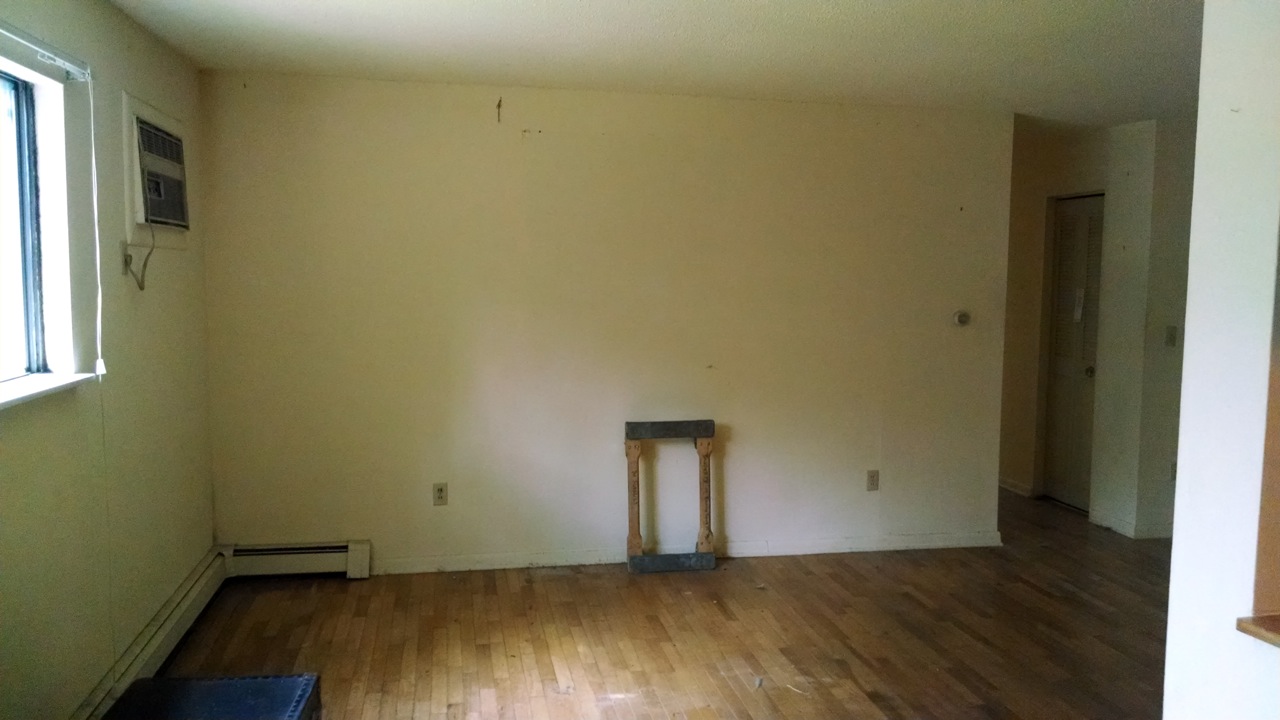
We have moved!
We’re not in our new place yet, just our summer place, where we’ve actually been spending our nights for a week now. Our days, though, have been spent at the old place, finishing up the packing. We filled the last box around mid-day yesterday.
Today the movers came and moved everything to our storage unit.
Jackie did great work on the move. She not only did much more than her share of actually packing things into boxes, she also ordered the boxes—and did an incredibly precise job of it. We filled almost 60 book boxes, a similar number of small and medium boxes, somewhat fewer large boxes, and a few specialized boxes (extra-large, electronic equipment, mirror, wardrobe). Jackie figured out how many of each kind to order, and when we were all done we had 3 extra book boxes (one or two of which we will use to pack up the tools that we kept on-hand in case we need any during the cleanup), 1 small and 1 medium box.
I also credit her hard work with saving us money on the move itself, which came in at about $150 below the estimate—mainly because with everything properly packed in advance, the movers were able to just load and unload, without having to fiddle around with stuff that wasn’t quite ready.
Here’s the living room early in the move—piles of boxes, all the shelves empty:
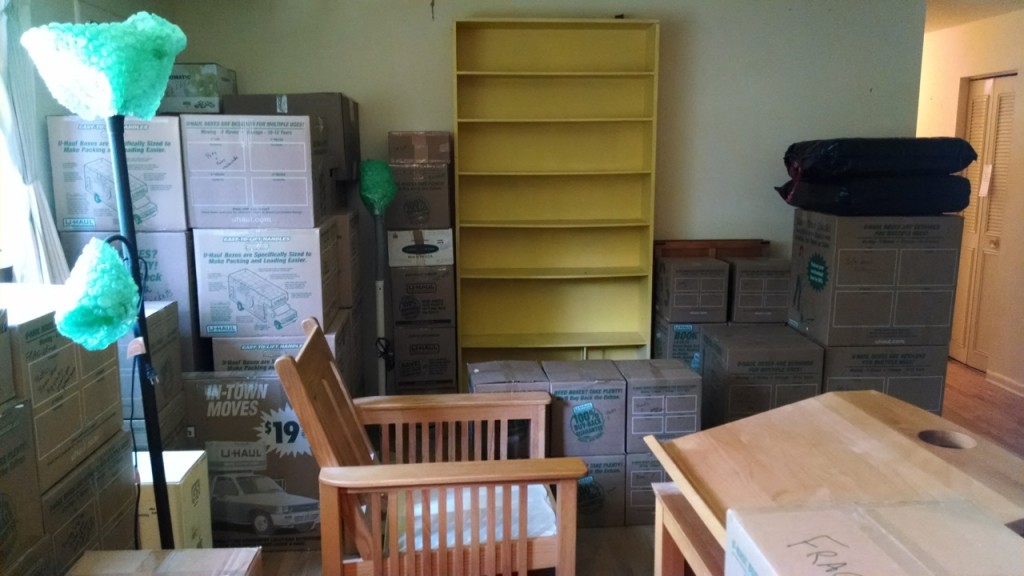 And here’s the living room late in the move:
And here’s the living room late in the move:
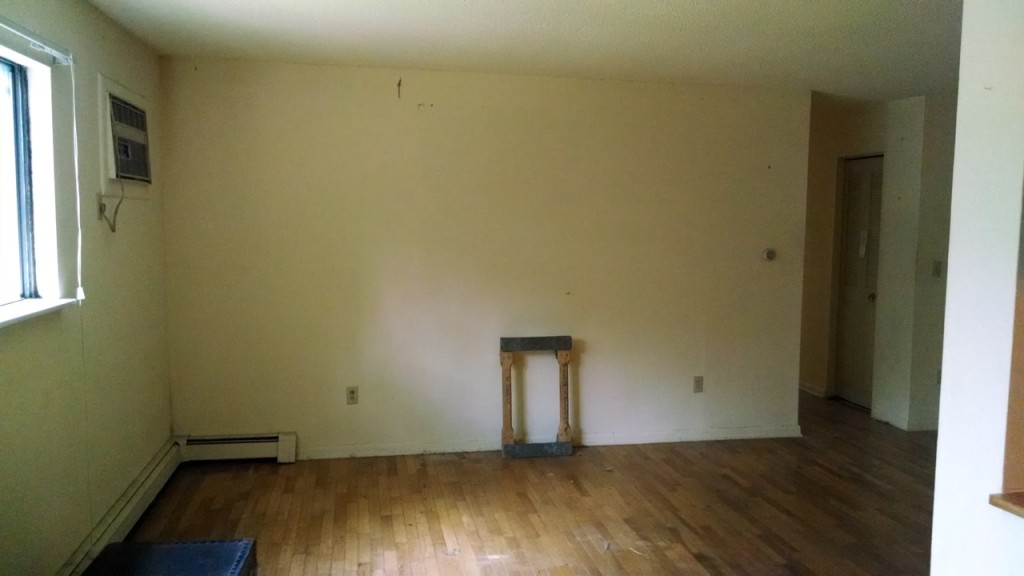 And here’s the view from near our storage unit:
And here’s the view from near our storage unit:
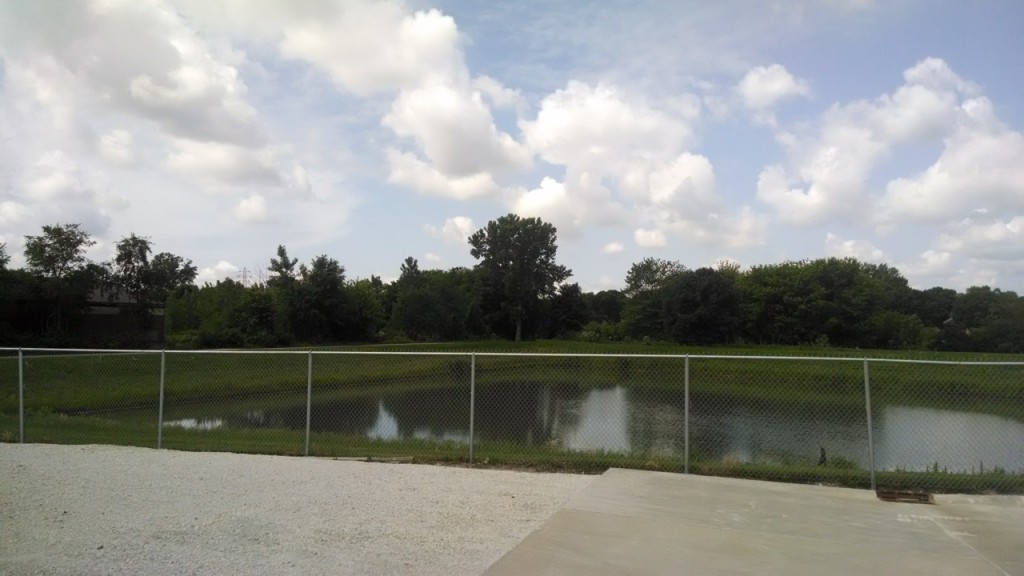 Tomorrow is my birthday; we’ll take the day off for some celebratory relaxation. The next day we need to go back to the old place and clean it, then schedule a walk-through with the management to make sure there’s no damage. It’s in very good shape, but I’m still mentally warming up to argue that “normal wear and tear” for a unit we’ve been living in for 14 years is more than might be expected after a 1-year rental. Hopefully it won’t be necessary.
Tomorrow is my birthday; we’ll take the day off for some celebratory relaxation. The next day we need to go back to the old place and clean it, then schedule a walk-through with the management to make sure there’s no damage. It’s in very good shape, but I’m still mentally warming up to argue that “normal wear and tear” for a unit we’ve been living in for 14 years is more than might be expected after a 1-year rental. Hopefully it won’t be necessary.
After that, we’re pretty much on vacation for the rest of the summer! I’ll be able to focus on my writing. Jackie will be able to focus on her spinning. (Not her weaving, as the loom is packed. Also not the knitting—she’d intended to have some knitting yarn, but used so much as packing material to go around fragile items, she ended up going ahead and packing the knitting needles as well.)
There’s a bunch of cultural stuff in Champaign in the summer that we hope to do, including Friday Night Live every week, and the annual Blues, Brews, and BBQs, not to mention the Taste of Champaign. It’ll be really handy to be so close to downtown for all that.
We can spend June and July enjoying all that, before we have to start worrying about where we’ll live in the fall. Hopefully, Winfield Village will get us a move-in date in good time, but if they don’t, we have lots of options, from visiting relatives to just renting a regular apartment, to taking an extended camping trip. (We made sure to bring our camping gear to our summer place, rather than packing it up.)
Progress on the novel continues apace.
In particular, I’ve reached the point where the action in the novel lines up with action in the failed short story that the novel draws from.
The short story failed because I simply couldn’t cram in all the setup needed, a problem easily solved in novel form—the setup occurs naturally in the body of the novel. As I wrote, I kept in mind the various bits that I needed to set up, and have been making sure to cover them as I went along.
With that done, I’d imagined I’d just about be able to copy whole scenes from the short story into the novel manuscript. Except, that turns out not to work. I tried it this morning, growing my story by about 1600 words, only a couple hundred of which were newly written prose.
Part of what’s in these scenes are the failed attempts to provide the setup. Since that setup is now provided (in full scenes of their own, earlier in the manuscript), I need to remove those attempts from these later scenes.
That turns out to be harder than I’d expected. The text I’m working on is near-final draft stuff. I had previously polished every paragraph, every sentence. Everything is all hooked together as smoothly as I could mange. Some things can be removed by just deleting a paragraph, but other things require a complete re-writing. Plus, a lot of things shouldn’t be removed entirely. Rather, the failed attempts to set something up should be replaced with a little call-back to the setup—a little memory-jogger that reminds the reader of what happened many pages ago, so that when it becomes significant, they say, “Oh, yeah. I remember that.”
The upshot is that I have another six thousand words or so ready to go in—but I now see that adding those words will be as hard as writing them would have been. Maybe harder.
After adding three scenes by copying and editing, I’m now thinking that it might be better to just write fresh scenes. (In fact, thinking about the amount of editing that remains to be done on the scenes I added this morning, that’s really starting to seem like a good idea. I’ll try it that way tomorrow.)
As I’ve been writing, Jackie has been working in her media—spinning and weaving mostly. She wove two silk scarves in the past weeks, and spend much of the past couple of days winding a warp for her next weaving project.
Here’s Jackie with the warp, chained up for storage or transportation, but ready to be threaded onto the loom:
It was on my first trip to England that I came to understand that what we think of as formal wear, business attire, and sports clothing was originally designed to be the most comfortable possible clothing for the circumstances. The circumstances in this case being the climate, technology, and infrastructure of England in the eighteenth and nineteenth century.
Without central heat interiors were going to be chilly, but even if you were quite frugal with your wood or coal they would not have to be really cold.
Given those indoor circumstances, and given that you had to make do with wool, silk, linen, and cotton (because there were no synthetic fibers), you would quite naturally end up with just the sort of garments that we now think of as being part of formal wear—wool coats and vests, silk bands to wrap around your neck, and so on. Sport clothing, of course, was for the sort of sports the English aristocracy engaged in: riding and shooting. Tweed and leather were very practical.
It seems obvious now, but it was something of a revelation to me. When I was younger, I always thought of that sort of clothing as being uncomfortable.
Partially that’s because such clothing is only really comfortable if it really fits. You don’t need a bespoke suit for it to fit correctly; even today good men’s clothing is routinely altered to fit. But clothing purchased for a child will never fit for long (and often never fit at all, because the child knows neither how the garment is supposed to fit nor how to articulate any issues discovered during the fitting).
Perhaps more important, such clothing is only comfortable in the sort of very cool environment for which it was originally designed. If your interior temperatures are around 60°F, you will be more comfortable in a wool coat over a wool vest than you would be in shirtsleeves. At 70°F it will be the other way around.
My attitudes toward such things has also been influenced by Jackie’s work with fiber. In my youth, my experience with wool was that it was scratchy, uncomfortable stuff (totally aside from it being made into garments that didn’t fit and were wrong for the climate). Now I’ve learned about the many different kinds of wool—starting with merino, of course, but by no means ending there—that are not scratchy. Now I have wonderful vests and sweaters, made to fit, from premium materials.
Of course, the top layers are really the last thing to think about. Comfortable clothing begins with the base layer. There again, my experiences as a child turned me against a whole very useful category: long underwear. Any clothing that you’re going to put another layer of clothing on top of needs to fit exactly right. An outer layer that’s too loose can be tolerated. But a too-loose under layer is going to get bunched up and shifted away from where it needs to be: Intolerable.
The ill-fitting hand-me-down long underwear I got as a child turned me against a whole category of garments that doubtless have an important role to play in comfortable dressing. I’m only now, more than two decades after returning to the Midwest, beginning to accumulate items for an appropriate cold-weather base layer. (I’ve made do up to now by having a wide range of top-layer options: spring jackets, fall jackets, winter coats, parkas, my Alaska pipeline coat.)
As a young man, I think I’d have been perfectly happy to wear nothing but shorts and t-shirts, and simply crank up the heat to make up the difference. My attitude has changed. If I had the money, I’d be very pleased to get and wear wool coats and vests, silk cravats, smoking jackets, and the like. Not because of the fashion statement they’d make (which would be a rather silly statement, however much I’ve come to appreciate a fine tweed), but because they’d be very comfortable.
Jackie has an update about her latest project, in which she’s weaving something called Huck Lace.
I mostly wanted to draw attention to the third picture, in which I captured Rapunzel “helping.” In this case, she’s helping by poking her face up through the warp.
Pure luck that I got that picture—her head wasn’t even headed that way when I pressed the button, but there it was in the captured image.
Jackie and I went to the Forest Glen Preserve, a nature preserve in eastern Illinois, over near the Indiana border.
We scouted the campgrounds, because the local Esperanto group is planning to some tendumado. We found two, although there’s at least one more.
One is a pretty ordinary Midwestern campground with a mixture of tents and RVs. It was pretty full, but only as crowded as you’d expect on Saturday morning of Memorial Day weekend. It had showers and flush toilets, firewood on sale, etc.
Near that one (but far enough away that noise wouldn’t be a problem) was the “tent campground.” It was different in that it didn’t have parking spaces for the campsites. There was an area just a few yards away where you could leave your car for up to 20 minutes to unload, and then you were supposed to move it to a parking area that was still really quite close—I’ve carried my luggage further in a hotel. Still, it seemed to be enough to discourage campers. Even Memorial Day weekend, there was nobody there—sixteen vacant campsites. (It did lack flush toilets. Also, the recent rain had left some of the campsites under water, although the dry sites were also vacant.)
Once we’d scouted the campgrounds, we went for a hike. We picked the Big Woods trail, which a posted list had described as the most rugged of the preserve’s trails. We took that with a grain of salt. Here in the flatland, pretty much any change in elevation seems to qualify a trail as rugged, but it was somewhat rugged. The train went down twice into ravines, then back up again, and ended at an observation tower at what I assume is the high point of the preserve.
We saw plenty of neat stuff—sugar maples and tulip trees, white oak, sassafras, ferns, various kinds of mushrooms. (I saw what might be the tallest sassafras tree I’ve ever seen. It was huge. I usually think of sassafras as being scrubby little things.)
The trail was muddy, but only very muddy in a few places (plus, of course, the places where it crossed running water). We ran into three very wet, dirty guys with tools who said they’d been doing trail maintenance.
The trail was only a little more than 1 mile, but out-and-back so we got in maybe 2 ¼ miles of hiking.
We left it at just that much hiking, because we still needed to go to the Viking Reenactment, which was the reason that we were visiting Forest Glen this weekend in particular.
Two of the reenactors seemed to focus on fiber crafts. One is a member of the spinners and weavers guild, and was using some of Jackie’s handspun yarn to demonstrate weaving with a warp-weighted loom. We had a fun chat.
The other fiber-crafty person told us about her theory of mud-colored peasants. Many reenactors, she said, end up with clothing in colors of sheep, because dyeing fabric is another whole skill that you need to learn—and making your own natural dyes is two or three more skills (growing or gathering dye plants, and learning how to prepare them for dye use). However, in her experience meeting actual modern-day poor peasants, even the really poor ones go to considerable effort to not be the color of mud. Hence, she proposed, actual Viking-era villagers probably wore clothing that was as brightly colored as possible, within the limits of the natural dyes that were available to them. (They had several sources of yellow, yellowish green, red, and purplish red. Blue was available. A really good green was tricky, because you had to get a good yellow and then overdye with blue.)
Despite her theories, all the other reenactors seemed to be wearing clothing in natural colors.
What with scouting and hiking and viking, it was already lunch time. We had lunch at Gross’ Burgers, then headed home (pausing just a bit at a rest stop to let a severe thunderstorm pass).
A good outing.

We keep our apartment cool, in the interest of minimizing our contributions to both resource depletion and global warming. Plus, Jackie likes to wear her woollies, which isn’t practical in a warm apartment. The only real downside is that, in a cool apartment, my hands get cold when I write. To address that problem, Jackie offered to knit me some fingerless gloves. (Click any of the pictures for a larger version.)
My first pair of fingerless gloves were knitted to my precise specifications. It’s made of fairly course yarn, which I figured would be fine for my purposes, and it has the fingers truncated almost completely, which I figured would make it easier to type.
Unfortunately, even just the row or two of knitting that formed the finger holes turned out make them a little uncomfortable for typing.
Since those weren’t quite satisfactory, I came up with a new design—fingerless gloves that not only had no fingers, they didn’t even have finger holes.
Jackie made these most lovingly. She not only spun yarn by hand, she spun it by hand while attending a science fiction convention (WorldCon in Toronto). The main color was hand dyed as well (with brazilwood). The yarn is wonderfully soft and fine. I got to pick the colors, and I picked these colors so that I could call them Rosebud Wristlets.
My Rosebud Wristlets were a complete success, and they’ve been my main fingerless glove for seven years (they were a Christmas present in 2003).
I liked them so well, I got Jackie to make a second pair that we gave to Kelly Link.
Not having fingers at all was great for leaving my fingers free for typing, but had a downside: My hands stayed warm, but my fingers sometimes got cold. So, I asked for yet another pair of fingerless gloves, this pair with fingers, but made from yarn so fine that it wouldn’t force my fingers uncomfortably far apart.
So, Jackie knit me this pair of fingerless gloves. Each glove finger extends out to the last knuckle of my finger. They’re made from machine-spun “fingering weight” yarn (perhaps called that because it’s the right weight to use when knitting glove fingers).
They’re wonderful. They’re not more wonderful than my Rosebud Wristlets, but they do keep my fingers warmer. So far I’ve been alternating between them, depending on whether just my hands are cold, or my fingers too.
For a while I’d imagined that I might design the ultimate fingerless glove, but it turns out, as usual, that the best tool for the job really depends not only on the precise details of what you’re trying to do, but also the precise circumstances under which you’re trying to do it.